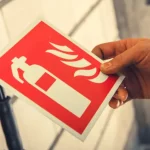As a retailer, you have a duty to ensure that your store is safe for your customers. Take a look around your premises.
Is everything OK?
See anything that might pose a danger to your customers?
What about fire hazards?
The most common problem areas are exposed wires from lights and computers, too many plugs, improper chemical storage in a storeroom, or combustible materials positioned near a heat source.
The Regulatory Reform (Fire Safety) Order 2005 came into being as a result of the government’s commitment to passing regulation only when and where necessary and in ways that suit the needs of modern business.
The order replaces almost all fire safety legislation in England and Wales with one simple regulation that compels anyone in charge of commercial premises to take steps to minimize the risks of fire and ensure that customers and staff can be evacuated safely and quickly in the event of a fire.
What sort of premises does the Order cover?
The Regulatory Reform (Fire Safety) Order covers almost all buildings, premises, structures, and even open spaces including
- Offices and shops
- Factories and warehouses
- Pubs, clubs, and restaurants
- Hotels and hostels
- Schools and sports centers
- Community halls and clubs
- Hospitals and care homes
- Retirement homes
- Places of worship
- Tents and marquees
What are the main provisions of the Order?
The Regulatory Reform (Fire Safety) Order specifies that the owners of premises should:
- Carry out fire risk assessments to determine any possible fire hazards, risks, or dangers
- Remove or reduce the risk of fire and put in place general fire precautions
- Create an emergency fire plan
- Ensure there’s sufficient protection for any stored flammable or explosive materials
Who is responsible?
Anyone who owns or controls any premises, or a person who has some control over a particular area or system, may be deemed responsible. This could be
- The employer for those areas where staff may be located or working
- Owners or managing agents for shared premises, or where fire safety equipment like sprinklers or fire warning systems are shared
- Occupiers of voluntary organizations or self-employed people with overall control
- Any other person or persons who control a part or portion of any premises
What about fire extinguishers on the premises?
As a rule of thumb, there should be one fire extinguisher for every 200 square meters of floor space, and at least one extinguisher on each floor.
To ensure you’re prepared for the event of a fire breaking out, always keep fire extinguishers in your shop and make sure your employees know how to use them.
You should also schedule regular fire extinguisher inspections to ensure that they are functioning properly.
Carrying out fire risk assessments
You need to walk through your premises and carry out a comprehensive 3 step fire risk assessment:
Step 1 should identify
- Sources of ignition such as heaters, or naked flames
- Sources that could fuel a fire such as textiles, display materials, or cardboard boxes
- Sources of oxygen such as air conditioning units
Step 2 should pinpoint those people who may be especially at risk. These will include:
- People working close to fire dangers like heaters or naked flames
- People who work on their own, or work in isolated areas like storerooms and lofts
- Parents with babies and children
- The elderly and infirm and those with disabilities.
Step 3 should evaluate the level of risk in your premises and remove, or reduce, any fire hazards where possible and reduce all other risks you identify. For example, you should:
- Ensure that any flammable materials are kept separate from any sources of ignition
- Where possible, replace highly flammable materials with less flammable ones
After you’ve reduced as many of the fire risks in your premises as possible, weigh up whether you’re able to take any further safety measures and if so, put these in place too.
Escape routes
It’s vital that you plan safe exit routes for people to leave the premises quickly and easily in the event of a fire. If possible, try to have more than one escape route. If only one route is possible you may need to make it fire-resistant or install an automatic fire detection system.
Try to keep the distance people have to travel to the fire exit/s as short as possible. Travel distance should be measured from the furthest point in a room to the final exit point from the building.
About Author:
This article was written by Dakota Murphey, an independent content writer working alongside the leading specialist cleaning service, Cleaning Industrial Solutions who were consulted for some of the information provided in this post.




![[Infographic] Boating Accidents & Safety Guide Infographic](https://www.safeandhealthylife.com/wp-content/uploads/2017/03/Infographic.png)